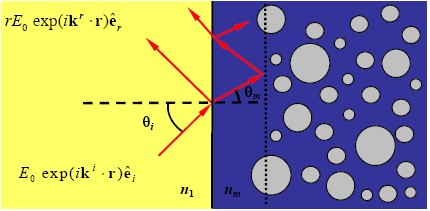We are approaching the calculation of the linear electromagnetic response of colloidal systems using an effective-medium approach. We have found that in the case of turbid colloids the corresponding effective medium is nonlocal (spatially dispersive), and nonlocal systems can sustain longitudinal modes besides the usual transverse modes. The idea is to understand, first, the role played by the longitudinal modes in the propagation of light in these systems and then to compare the results obtained within an effective-medium approach with the ones obtained using a multiple-scattering approach. We are also interested in the calculation of the reflection amplitudes of turbid colloidal system with a flat interface using both, the effective-medium and the multiple-scattering approach, and then to perform experiments in order to validate and understand the theoretical results.


We are interested in the calculation and measurement of the optical response of gold nanoparticles adsorbed on small TiO2 crystallites during the exposure of the system to CO and O2 where the gold nanoparticles act as a catalyzer in the conversion of CO to CO2 in the presence of different chemical environments. The idea is to follow the behavior of the gold plasmon peak during the chemical reaction in order to construct a model that could describe the role played by the gold nanoparticles. The experiments measured the specular reflectance of the gold nanoparticles adsorbed on TiO2 plates, which were obtained by pressing the TiO2 crystallites together. The experimental set up allowed the intake of gases to produce the chemical reaction. We believe that more sensitive results could be obtained by measuring the diffuse reflectance of samples of TiO2 crystallites in powder within an integrating sphere. We are in the process of performing the experiments and setting up the calculations.